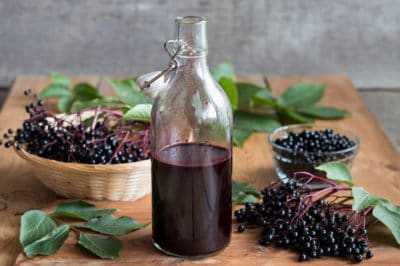Identifying Elderberries
It is good to know what elderberry trees and fruit look like. There are some plant look-alikes that can be toxic, so it’s important to know how to find the right, edible plant.
The first thing to know is that the elderberry bush can grow from five feet tall to as much as 12 feet. While there are smaller, ornamental elderberry plants, they are not usually found growing in the wild. The leaves of the elderberry bush are pointed and narrow.
Elderberry plants grow white flowers on an umbel, an umbrella-like construct; as a result of this, the elderberry fruit grows in a broad cluster rather than on the narrow stem seen on impostors. Beyond this, the fruit of the elderberry is usually black, dark blue-black, or red.
What Parts to Eat
The elderberry is edible when cooked. Most recipes call for cooked berries. As previously mentioned, elderflowers are edible, too. You should not eat the stems, leaves, seeds, or roots of the elderberry plant. These parts of the plant contain a chemical that creates cyanide when digested and can cause severe illness and symptoms including:
- Nausea
- Vomiting
- Diarrhea
- Headache
- Abdominal pain
- Dizzyness
- Confusion
What Isn’t an Elderberry
The chokecherry (also called chokeberry) can appear similar to the elderberry, and is edible although it’s quite sour until cooked. The chokecherry’s bark is usually grey or reddish brown, but turns dark as the tree ages. The fruit is usually dark red or black and the leaves are dark green and serrated.
Pokeberries are also confused with elderberries. Since the pokeberry is generally unsafe to eat it’s a good idea to avoid it. The pokeberry plant has red stems and it’s berries grow in a narrow, conical bunch, rather than on the broad, rounded umbrels of the elderberry. The berries are a deep purplish black color and usually appear in early fall. The pokeberry’s leaves are broader than those of the elderberry and have a more ruffled edge.
When in doubt about the nature of a plant it’s advisable consult an extension office, master gardener, or other plant professional for the additional advice.
